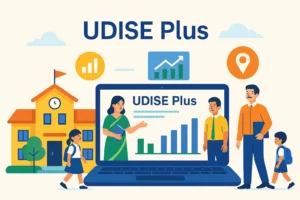UDISE Plus – Complete Guide to India’s School Data Portal
Introduction: What UDISE Plus Means for School Data in India
India runs one of the largest school systems in the world. Managing this scale requires reliable, real-time data. UDISE Plus (Unified District Information System for Education – Plus) is the government’s official platform that captures information about schools, teachers, and students. Operated by the Ministry of Education with support from the National Informatics Centre (NIC), it strengthens planning, monitoring, and policymaking across the education sector.
What Is UDISE Plus? (Full Meaning & Scope)
The full form of UDISE Plus is the Unified District Information System for Education – Plus, a nationwide digital system designed to collect and manage school-related data. Covering institutions from pre-primary to Class XII, it maintains details on enrolment, infrastructure, staff, and results. UDISE Plus serves as a single platform where policymakers, administrators, and even parents can access verified school data.
Evolution: From UDISE to UDISE Plus
India earlier depended on two separate systems: DISE for elementary education and SEMIS for secondary schools. In 2012–13, these merged to form UDISE. In 2018–19, the government upgraded it into UDISE Plus, shifting to a web-based, real-time format. This transformation added features like GIS mapping, geotagged school photos, and public dashboards, making the data more accurate and transparent.
Objectives & Benefits of UDISE Plus
The UDISE Plus portal delivers multiple advantages:
- Data-driven planning – Offers insights for allocating funds, teachers, and infrastructure.
- Better monitoring – Tracks access, quality, and inclusivity in education.
- Parent-friendly transparency – Through the Know Your School (KYS) feature, citizens can check school information.
- Equity focus – Identifies gender gaps, dropout trends, and accessibility issues.
- Digital convenience – Minimizes paperwork and speeds up annual school surveys.
How UDISE Plus Works: Data Flow
Data travels through a structured flow before becoming part of the national database:
- School Level – Teachers or heads fill out the Data Capture Format (DCF).
- Block Level – Local MIS officers verify entries.
- District and State Level – Officials compile and review records.
- National Level – The Ministry of Education finalizes data and prepares reports.
This process ensures each figure is validated multiple times.
UDISEPlus Modules Overview
The system offers dedicated modules for different functions:
- School Profile & Facilities – Tracks classrooms, electricity, labs, and playgrounds.
- Teacher Module – Maintains teacher records including service history, training, and transfers.
- Know Your School (KYS) – A search feature that allows the public to look up schools by name, UDISE code, or PIN.
- GIS & Image Upload – Geotags schools and allows uploading of photos for verification.
- User & Directory Management – Supports admins in handling new school entries and access roles.
UDISE Plus Login & Access
Access to UDISEPlus depends on user roles:
- Schools – Use their UDISE code as the username.
- Block & District Officers – Verify data and resolve issues.
- State Authorities – Generate comprehensive state-level reports.
Users can sign in via the UDISEPlus portal or SDMS login.
UDISE Plus Code & School Search
Every school receives a unique 11-digit UDISE code. Parents, teachers, and officials can search schools on the KYS portal using:
- School name
- UDISE code
- District or PIN code
Results show enrolment, teachers, medium of instruction, and available facilities.
UDISE Plus Data Entry & DCF
The Data Capture Format (DCF) is the main survey tool within UDISEPlus. Schools update it every year with:
- Enrolment details by class, gender, and category
- Teacher qualifications, training, and subject specialization
- Infrastructure (toilets, ramps, ICT, electricity, drinking water)
- Student performance and progression
Accurate DCF entries ensure that planning and funding decisions align with ground realities.
UDISE Plus Reports & Analytics
Reports generated from UDISEPlus highlight:
- Key student indicators like enrolment ratios (GER) and gender balance measures (GPI)
- Dropout and transition rates across grades
- Infrastructure growth such as computer labs and safe sanitation facilities
- Teacher availability measured through pupil-teacher ratios and subject coverage
The government shares these reports on data.gov.in, making them accessible to policymakers, NGOs, and researchers.
UDISEPlus Recent Updates
Some recent improvements include:
- A redesigned Teacher Module for better record-keeping.
- Integration with state EMIS systems like SARAL in Maharashtra.
- Reports showing more than 1 crore teachers are now part of India’s education system.
These updates strengthen both accuracy and usability.
Common Issues & Troubleshooting
Users sometimes face problems such as:
- Forgotten passwords – Local MIS officers reissue login credentials.
- Incorrect entries – Schools resubmit corrected data via official approval channels.
- School creation queries – Admins can check and confirm status in the directory module.
Data Security & Privacy in UDISEPlus
To protect information, the Ministry enforces strict measures:
- Role-based permissions – Only authorized users can edit records.
- NIC-managed hosting – Ensures secure infrastructure.
- Public access limits – Citizens can view data via KYS but cannot modify it.
FAQs
It is India’s central online platform for collecting and managing school data.
The term means Unified District Information System for Education – Plus.
Search through Know Your School (KYS) by school name, UDISE code, or PIN code.
Schools log in using their UDISE code, with passwords provided by block or district MIS officers.
It records student enrolment, teacher profiles, facilities, infrastructure, and results.
Yes, reports are published on data.gov.in, and school-level information is visible through KYS.
Yes, it includes government, private, and aided schools from pre-primary to Class XII.
Reports show over 1 crore teachers, improved digital facilities, and steady implementation of NEP 2020 goals.
Conclusion
UDISE Plus has become India’s backbone for school education data. By moving to a digital, transparent, and centralized system, it supports fair resource allocation, improves accountability, and helps parents and policymakers alike. As India advances with the National Education Policy 2020, UDISEPlus will continue to guide decisions shaping the country’s educational future.
